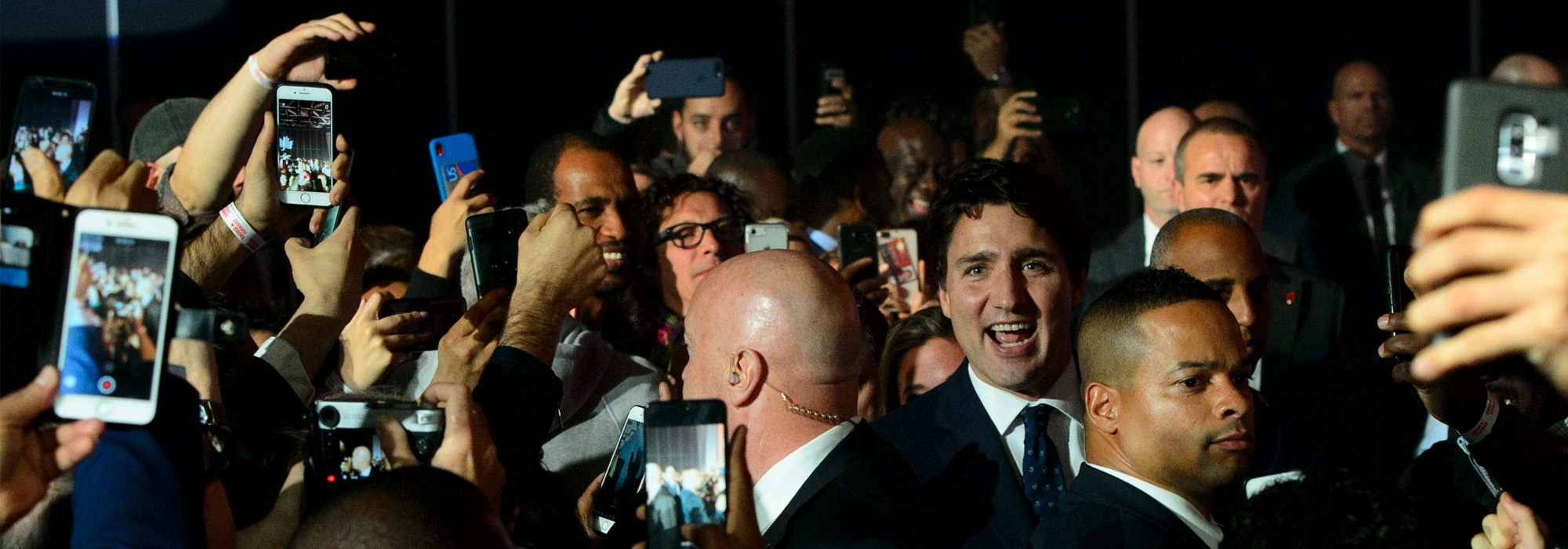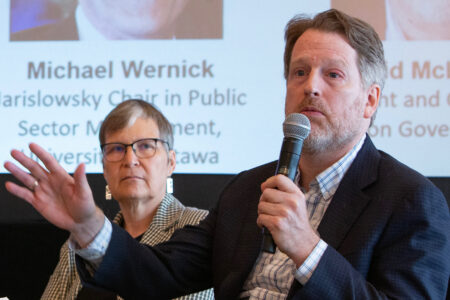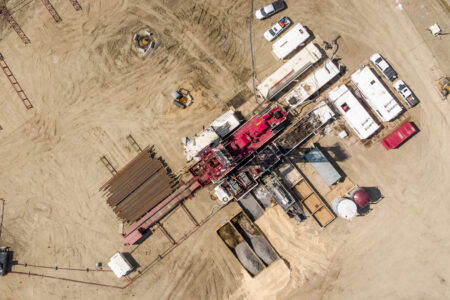
(This article has been translated into French.)
Even in the midst of a global pandemic, electoral politics marches on. Right now, there is an organizing frenzy unfolding around the Conservative and Green Party leadership races. Saskatchewan is gearing up for its provincial contest in October, and candidates in New Brunswick await the rescheduling of provincial by-elections.
But what most citizens see during a campaign are the candidates and especially the frontrunners; the media are fixated on the horserace, and when the results are in, winners are celebrated, losers look inward, and everyone begins preparing for the next contest. Relatively few Canadians know what happens beyond the headlines, and the workers behind the scenes who make it all come together. Canadian election campaign machinery can be a mystery to everyone except those who are on the inside. But to understand politics, citizens need awareness of what goes on behind the scenes.
We depend on journalists to explain and political operatives to talk. Problem is, media reports tend to dramatize, and political parties coordinate tightly scripted events to drive home a message. Meanwhile, few campaign workers are willing to divulge campaign strategy or tactics for obvious reasons. The small number of politicians and staff who disclose insights are likely to present a one-sided account many years later. Very rarely do practitioners treat us to timely and forthright disclosures, such as the revealing Policy Options essay by the Liberal Party’s 2019 campaign wagon master or the exposé Harper’s Team by former Conservative campaign strategist Tom Flanagan.
Imagine if you were a student enrolled in Carleton University’s Graduate Program in Political Management program seeking information about roles in a Canadian election campaign. Where would you look? There is no Canadian resource for students, researchers or anyone else to turn to.
A unique book that blends practitioner insights with academic rigour has joined the small canon of insider treatment of Canadian election campaigns. Structured around the 2019 Canadian federal election, the newly released book Inside the Campaign: Managing Elections in Canada (UBC Press, Alex Marland and Thierry Giasson co-editors) brings together academics and practitioner authors to examine what happens behind closed doors during a Canadian campaign. Each chapter explains the varied roles of party strategists, public servants, journalists, pollsters, and candidates. Elections are about choosing who wields power and who represents citizens; understanding the work of the people who help shape these choices, and how they do it, is what this book is about. Revealing how elections are managed may help Canadians appreciate the considerable work involved with coordinating a campaign as well as help them look beyond spin and debunk Hollywood-fuelled myths about political operatives.
The 2019 campaign is an interesting backdrop because novel approaches to message control during former prime minister Stephen Harper’s years are now routine. Yet much has changed as digital communications has become the campaign battleground. As well, 2019 featured its share of campaign drama, in particular the Justin Trudeau brownface/blackface controversy.
The 2019 campaign was comprised of two parallel contests. The Trudeau Liberals and Scheer Conservatives competed to form government while other parties jostled to elect at least 12 MPs and achieve official party status. The results showed that campaigns matter. Much of the talk afterwards was rightly about the Liberals staying in office, albeit with a minority government. Andrew Scheer was the target of blame for a missed opportunity to topple the Liberals. At the start of the campaign, few would have predicted that the Conservatives would pull off the rare feat of winning the popular vote yet not form a government, or that the Bloc Québécois would be resurrected from near collapse.
Many Canadians were evidently uninspired by Trudeau and Scheer, turning instead to the Bloc’s Yves-François Blanchet or NDP leader Jagmeet Singh. The Greens had an electoral breakthrough and yet failed to capitalize on public concern about climate change. The 2019 campaign will also be remembered for the involvement of Maxime Bernier’s People’s Party of Canada, even though Bernier himself failed to be elected.
We believe that many people who follow Canadian politics are interested in getting beyond the headlines into the machinery of a campaign. To learn more about the roles of organizers, strategists, thinkers and planners who want to be as prepared as possible and who work in a high-stakes, high-pressure environment. Canadian campaigns are nowhere near the large, well-funded operations of their American counterparts. In Canada, where budgets are tight and the media glare less bright, instead of expensive political consultants there are party personnel and volunteers. A lot of what goes on in Canadian campaigns is trial by fire.
There are arguably more similarities between the two country’s politics in the weeks leading up to an election. As a campaign approaches, politicians and party personnel look to leverage all available opportunities to gain a rhetorical advantage. There is an extra push to win news cycles, to out-fundraise opponents, to recruit candidates, to build a campaign platform and to frame their adversaries in a negative light. In Canada, the governing party lavishes budget goodies as ministers fan out to re-announce spending initiatives. In 2019, for the first time, campaign spending limits were in effect for political actors during a pre-election period, from June 30 until Trudeau announced the election on September 11. With fixed-date elections, activist groups, polling companies and news organizations are at the ready, too.
Intense election preparedness extends beyond the political parties that comprise the heart of the competition. Permanent campaigning engulfs party politics in Canada. Pollsters, newsrooms, and interest groups engage in extended strategic planning exercises. They incorporate market research, data and analytics, and public consultations in order to understand, contextualize, and predict how the parties and voters will behave. The bureaucracy and other agencies also brace for an election months in advance. Select political staff assist with the caretaking mode of government when the official campaign period is underway, and electoral administrators galvanize their extensive resources to ensure the accessibility and integrity of election day.
Everyone involved in a campaign must be on guard for criticism. For example, in 2019 the newly formed Leaders’ Debates Commission faced numerous critiques about the crowded stage and the format of the English debate, while all parties were lampooned for insufficient vetting of their candidates. Pundits pile on to any hint of mistake or controversy and offer campaign workers no room for error.
New research about campaign work is essential if we are to grasp the intensification of digital technologies as the driving force behind Canadian campaigns. Political parties are prioritizing digital campaign strategy that integrates advertising, voter outreach, fundraising, and field organization. Multiple versions of digital ads are tested to find what resonates with target audiences. Interweaving data with digital platforms – and leveraging resources such as social media influencers – is a key contributor to building campaign platforms, raising funds, and mobilizing support on election day.
Unfortunately, digital strategy is destined to go undocumented. Nobody wants to disclose the thinking behind innovative campaign technologies. The little that we know is anchored in journalistic accounts of the Liberals’ digital and data prowess from the 2015 campaign. While Inside the Campaign does not get into big data, it shows how digital has become a central focus of all aspects of campaigning. The desire of academics and others to examine and understand the digital foundations of campaigns is increasing. Pressures wrought by the threat of disinformation in elections, privacy concerns about data, and cyber-security measures with which parties must contend are going to dominate campaign preparations. But will Canada’s political operatives be willing to share their digital secrets?
Shedding light on how Canadian political parties manage these evolving campaign dynamics is an ongoing research challenge. Inside the Campaign shows that practitioners can offer meaningful insights into the machinery of campaigns, and that fruitful writing partnerships between campaign strategists and academics are possible. Elections are intense tasks involving thousands of Canadians, some of whom are more visible than others. We can only understand campaign work if campaign workers are willing to share information. Democracy is more transparent and inclusive when they do.
This article is part of The Insider’s View Behind the Scenes of Election Campaigns special feature.












